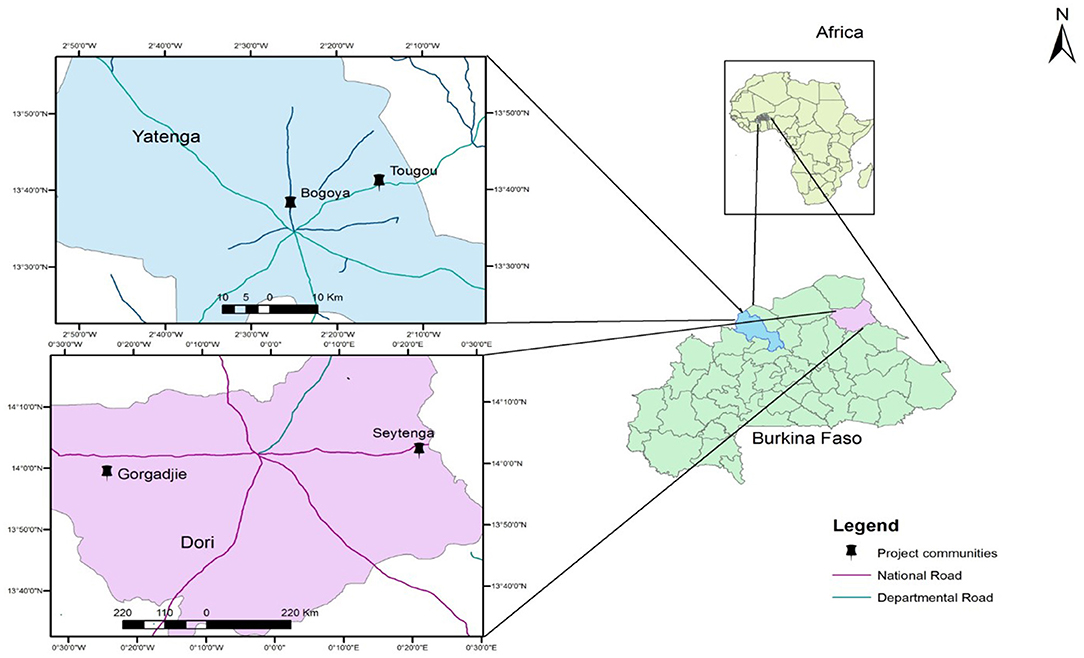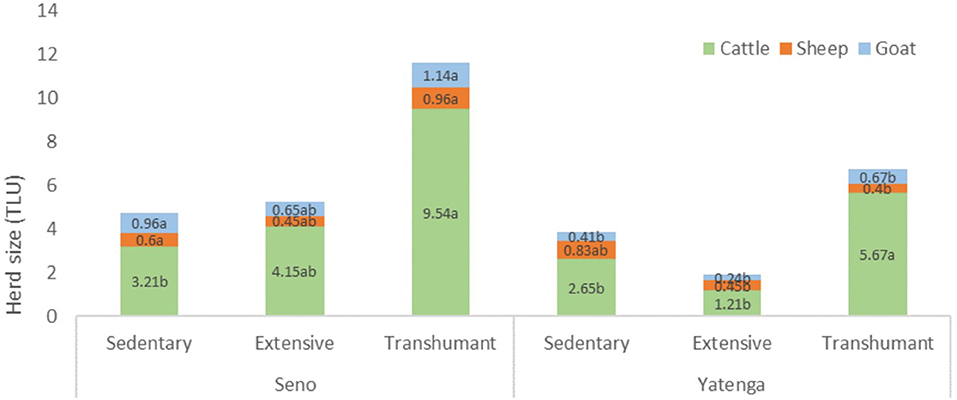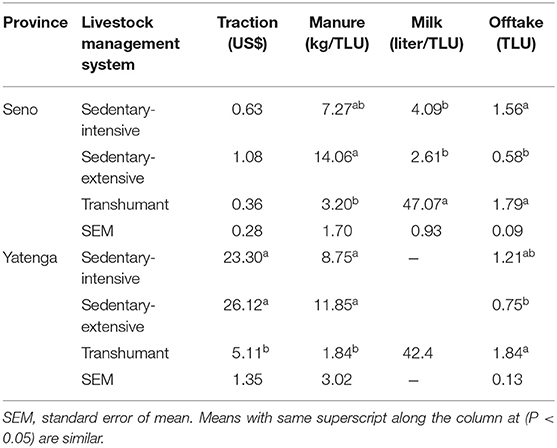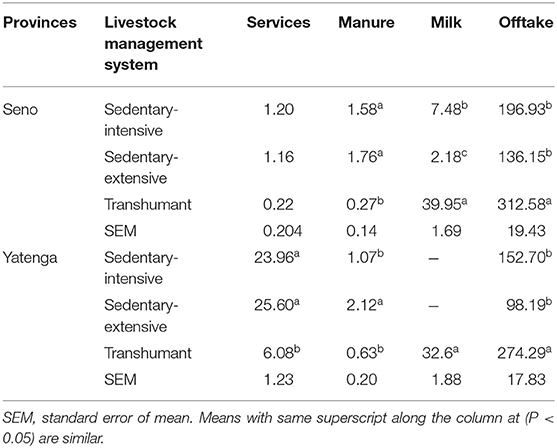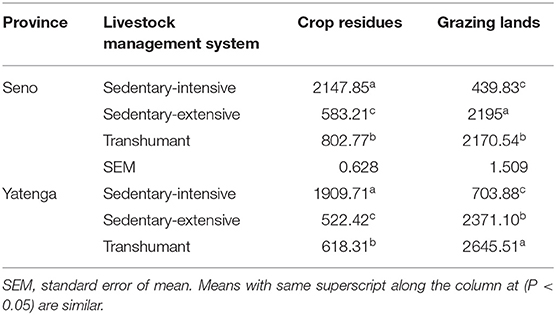- 1International Livestock Research Institute, Ibadan, Nigeria
- 2International Livestock Research Institute, Dakar, Senegal
The expected increase in livestock production to meet its increasing demand could lead to increased water depletion through feeds production. This study aimed at estimating the amount of water depletion through feeds and its corresponding productivity in livestock within the three dominant livestock management systems namely sedentary-intensive, sedentary-extensive, and transhumance in Yatenga and Seno provinces in the Sahelian zone of Burkina Faso. Using a participatory rapid appraisal and individual interview, beneficial animal products, and services were estimated, and consequently, livestock water productivity (LWP) as the ratio of livestock products and services to the amount of water depleted. Our results showed feed resources are mainly natural pasture and crop residues are common in all the management systems though the proportion of each feed type in the feed basket and seasonal preferences varied. Consequently, water depleted for feed production was similar across the systems in both provinces and ranged from 2,500 to 3,200 m−3 ha−1 yr−1. Values for milk (40 US$US$/household) and flock offtake (313 US$/household) derived from the transhumant system were higher (P < 0.05) than those from other systems in the Seno province. With higher returns from the beneficial outputs, LWP was higher (0.11 US$ m−3) in the transhumant system than other systems in Yatenga, but similar with sedentary-intensive in Seno Province Multiple regression analysis results showed that LWP had a significant positive relationship with flock offtake in Yatenga but milk and flock offtake in Seno. The study concluded that sedentary-intensive and transhumant system with more market-oriented beneficial outputs and much dependence on less-water-depleted feed resources will improve livestock water productivity in dry areas. Besides, interventions to improve livestock water productivity through beneficial outputs must recognize the unique socio-cultural context of the livestock farmers.
Introduction
Sahelian agriculture faces extreme climate variability exacerbated by climate change. The factor diminishes the availability of land for food production or grazing, deplete water, and increase the vulnerability of the people living in the region. Despite these challenges and conditions, livestock still play an important role in food security strategies (Ayantunde et al., 2011), risk aversion and socio-economic space among rural farmers. Among the major livestock inputs, feed, and water are the main limiting factors for livestock productivity in the Sahel (Amole and Ayantunde, 2016). Seasonal variation of major feed resources results in shortage of supply of quality feed, particularly in the dry season and has implications on the livestock productivity (Fernandez-Rivera et al., 2005). Erratic rainfall increase usage and annual climatic variations also place pressure on limited water resources in same region. Increasing demand for livestock products presents opportunities, especially for small-hold farmers, to supply livestock products, it also puts pressure on the natural resource base, including pressure on water resources (Wright, 2013) in an already water stress region. Thus, increasing the necessity to improve water productivity in sustainable ways (Delgado et al., 1999).
Livestock use of water and contribution to water depletion trends are high and growing (Steinfeld et al., 2006). Many authors have reported that water for livestock drinking and servicing is the most obvious water use in livestock production systems (Peden et al., 2007, 2009). However, it constitutes only a minor part of total water consumption as compared to water use for feed production, which is generally about 50–100 times the amount needed for drinking (Peden et al., 2007; Gebreselassie et al., 2009) where livestock depend solely on cultivated forage. Knowing that the challenge of water scarcity will continue in the years to come, it is worthwhile to consider suitable options for optimizing water use in livestock production.
Livestock water productivity (LWP) is the ratio of livestock products and services to the amount of water depleted and degraded in producing them (Kurz et al., 2006; Peden et al., 2007). Livestock convert water resources into high-value goods and services, comprising many different products varying from meat and milk, manure, draft power and transport, and other services such as nutrient cycling, risks spreading and socio-cultural roles (Thornton and Herrero, 2001). The variation in types and quantity of outputs from livestock may depend on the management systems, and of course feed availability and feeding systems. Livestock products and services depend on feed production which is the prime user of water resources for livestock production (Peden et al., 2003). Consequently, livestock keeping has important impacts on water resources within the environment.
Options of improving LWP have been discussed including animal management strategies (Descheemaeker et al., 2010). However, how livestock management practices in difference location affect LWP remain a gap across regions. Understanding the spatial variability of LWP among major Livestock Management Systems (LMS) in the Sahel could help in identifying the gaps in water usage and livestock-derived benefits within each system. This may consequently open pathways to increasing LWP within the dominant LMS in the region. Many authors have documented livestock-water interactions (Peden et al., 2007; Descheemaeker et al., 2010) and particularly focusing on livestock systems grouped based on crop typology, watershed, and farmers' wealth categories. There remains limited available information on LWP based on the dominant livestock management systems in West African Sahel. The objective of this study was to quantify the LWP among the three livestock management systems namely: sedentary-intensive production system, sedentary-extensive and the transhumant systems in Yatenga and Seno provinces in the Sahelian zone of Burkina Faso. This is hoped to inform the nature on intervention among the three different systems in order to enhance the livestock-water interaction as the climate changes and impact water resources in the Sahelian region. The two provinces are very different in terms of ethnicity and livestock tradition. Seno province is dominated by the Fulani who are pastoralists by tradition while Yatenga province is dominated by Mossi, mostly crop farmers. We hypothesized that good animal husbandry practices and beneficial output from each livestock management system improve livestock water productivity.
Materials and Methods
Location
Burkina Faso is a landlocked country located in West Africa in a semi-arid area with a dry tropical climate. The study was carried out in Yatenga province in the administrative northern region and Seno Province in the administrative Sahel Region of Burkina Faso. The maps of the study sites in each province are presented in Figure 1. Yatenga and Seno provinces were selected based on availability of targeted livestock management systems with contrasting production potential and ethno-cultural backgrounds.
Climate and Vegetation
Yatenga and Seno provinces are situated in the Sahelian agro-ecological zone. The climate is characterized by an extended dry season from October till May, rendered even drier by the cold dry season between December and February (Sanou et al., 2016). The average annual minimum and maximum relative humidity for this period are 26 and 62.8%, with an overall average of 44.4% (Some et al., 2006). Rainfall in the study areas is a crucial climatic element, varying in amount, timing and intensity. Long-term drought and erratic rains expose soils to degradation and subject them to erosion as the soils in the area have poor water retention capacity. Although both provinces have annual average rainfall between 400 and 600 mm, Yatenga province which could be considered as the southern Sahel receives more rainfall than Seno, a northern Sahelian region (Fontes and Guinko, 1995).
Yatenga and Seno record an average daily temperature of 35.9 and 37.2°C, respectively (Plan Communal de Developpement 2014–2018 version finale from the Ministere De L'administration Territoriale et de la Decentralization). In the study areas, the year can be divided into three major seasons: the rainy season (June to October), the early dry season (November to January), and the late dry season (February to May). These three seasons define biomass availability: in the wet season the crops are grown, and a lot of biomass is available in the rangelands; in the early dry season there is still some vegetation present and crop residues after the grain harvest, while at the end of the dry season biomass availability is lowest and there is a shortage of grazing resources and crop residues. The vegetation is comprised of thorny steppes dominated by Fabaceae-Mimosoideae species, banded thickets and somewhat eroded tiger bush (Thiombiano et al., 2012). Yatenga soil is classified as gravelly soils, with poor water-holding capacity and low fertility, and are shallow and prone to extreme runoff. They are typified with low in organic matter, nitrogen, phosphorus and calcium contents and are sensitive to erosion (Some et al., 2006). Most soils in Seno are made of clayey-sandy materials due to their aeolian origin (sandy deposits are blown by the wind) and the low rainfall, which does not allow for much leaching of clay material. They have a solid structure, a low to average cohesion and low organic matter contents (<3%).
Farming Systems
Yatenga province is composed predominantly of Mossi tribe who are dominantly agro-pastoralist combining crop and animal production, with more emphasis on crop and in proportions that vary according to climatic and socio-economic conditions, resulting in diversified production systems (INERA (Institut de l'Environnement et de Recherches Agricoles), 1995). Farming is largely based on hand-held tools: animal traction has been promoted by extension services, with manuring, value addition, composting, water conservation, and small-scale mechanization (Ayantunde et al., 2020) Agriculture is intensified through the introduction of Zaï and stone bunds, improving soil and water conservation (Douxchamps et al., 2014). Most farms are of small areas usually <5 ha (FAO, 2014). The main crops produced are sorghum, millet and maize as staple foods. Crops are grown once a year, during the rainy season with generally low yields. Livestock management is mainly extensive involving cattle, sheep, goats, and poultry.
In Seno, the basic economic activity is largely based on livestock production characterized by high mobility or transhumance. Livestock production is traditionally the mainstay of the predominant ethnic group that is, the FulBe (Peuhl or Fulani) in the province. However, with changes in climate and land use, agro-pastoralism is increasingly practiced in Seno province. For the management of the herds, some with large number of animals and small land areas are forced to practice transhumance over a 5–7 months period in search of feed and water (Zampaligré et al., 2013). Typical features of the three livestock management systems in the Yatenga and Seno province (sedentary-intensive livestock management system (majorly fattening), sedentary-extensive (free-ranging) and the transhumant systems) are discussed in the following sections. These systems were described as the main production systems of livestock farming in Burkina Faso (Ministry of Livestock Resources, 2011; Ayantunde et al., 2014, 2018; Catholic Relief Services (CRS), 2014). The livestock management systems under study have peculiar distinctions in terms of practices.
A sedentary-intensive system is often practiced for fattening animals that are sold in local markets (Diallo and Boundaogo, 2011). There is total confinement of the livestock within perimeter fence housing with intensive feeding (cut-and-carry) with feed resources such as forages, legume crop residues and agro-byproducts such as cottonseed cake and wheat bran. On the contrary, in the sedentary-extensive, animals roam freely in the community but are sometimes provided shed for shelter during the rainy season. Animals depend on natural pastures, household waste and crop residues left on the field as feed resources. There is minimal surveillance of the animals under this management system (Ministry of Livestock Resources MRA, 2007). Unlike the formal, transhumance is characterized by seasonal and cyclical movement of varying degrees between complementary ecological areas (SWAC/OECD, 2007). Transhumant production systems are operated mainly by Fulani pastoralists, within Burkina Faso but also extending north to and from Mali and Niger and extending south to the coastal countries particularly Benin and Ghana. The average cattle herd size under transhumant system is more than 35 Tropical Livestock Unit (TLU) (Zampaligré et al., 2013) and tends to focus more on milk. The transhumant herders often have a permanent homestead where the older members of the community remain throughout the year. Transhumance is more dominant in Seno province than in Yatenga.
Data Collection
In calculating LWP, major data sets were required: household composition, crop and land use, livestock production systems including feeds, services and products and other socio-economic. These data were both collected empirically and through secondary data. Primary data were collected through interviews, field observations and discussion with key informants to generate the data.
Household Survey
A total of 200 households in four communities within the two provinces were identified and randomly selected for the study consisting of 50 households in each community representing the dominant livestock management systems namely sedentary-intensive, sedentary-extensive and transhumance. Number of selected households for each livestock management system in the study sites are presented in Table 1 depending on the number of respondents available in different communities. There were more household in both sedentary-extensive and sedentary-intensive system; the survey limited the number to 20 per community. A Participatory Rapid Appraisal (PRA) was used in discussing with representative farmers (25 farmers) in each community in a focus group discussion (FGD). This provided general information on the farming systems, livestock feeding issues, crop and livestock products, yield measurement, and other related issues. This was followed by individual interview of farmers selected based on their dominant livestock management system using a semi-structured questionnaire. The questionnaire comprised questions on household composition, household socio-economic profiles, livestock holding and herd composition, production of livestock products (milk, sales of live animals as flock offtake and manure) and services (transport, draft power), land holding, cropping patterns, crop yields, and feed resources. The survey covered information on crop and livestock production within 12 months as it was difficult for farmers to give detail and dependable information for over a period of 1 year. However, information regarding the crop production, livestock numbers and density were also generated from province agricultural and rural development office. Tropical Livestock Units are livestock numbers converted to a common unit.
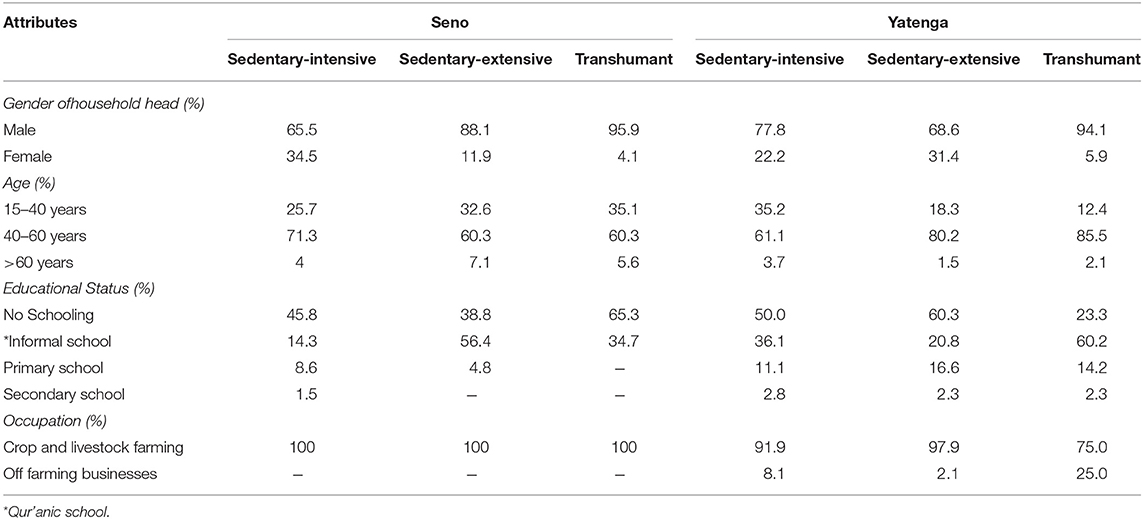
Table 1. Household demographic and socio-economic profile of respondents across the study sites (in percentage).
Due to scarcity and difficulty in obtaining some relevant data, this study relied on specific information both from gray literature and published data which are discussed below. These were used to make certain assumptions. We recognized that these assumptions were no inexhaustive and may be limited in their application in another context.
Estimating LWP
As described by Peden et al. (2007) and elaborated by Gebreselassie et al. (2009) and Descheemaeker et al. (2009) Livestock Water Productivity (LWP) is the ratio of livestock beneficial outputs and services to water depleted to produce livestock feed. To understand the LWP in each livestock management system, LWP values were aggregated into the related system in all the communities, using the equations derived from Peden et al. (2007).
where i is the unit of observation per household, LWP livestock water productivity (US$/m3), Oi the quantity of livestock outputs (milk, flock offtake, and manure), Si the service type (traction) obtained per year, Pi the local market price (US$) of each outputs and service type; WDk the amount of water depleted in evapotranspiration for production of animal feed resources (crop residues, grazing land).
Estimation of Water Depleted in Producing Livestock Feed
Depleted water was computed from the amount of water that is lost through evapotranspiration (ET) using CROPWAT (FAO, 2003) software and NewLocClim database. In order to arrive at the total depleted water for each crop grown and grazing areas, the following equations show mathematical relation of the different data sets used in calculating water depleted for livestock feed:
where;
ETci = the total water depleted for I crop types biomass (grain and crop residues) or grazing land in meter per hectare during growing season in the different system
ETo = the average reference evapotranspiration in m/day of the different system
Kci = crop coefficient of the crop type/grazing land i at different growth stages t
LGPij = Length of growing period in days of the crop types/grazing land i in different system.
FAO (1992) recommended the Penman-Monteith method as a standard method for the computation of the reference evapotranspiration (ETo). Reference evapotranspiration calculated for Yatenga province was from Ouahigouya metrology station whereas for Seno province Dori meteorology station was used. The Length of Growing Period (LGP) used for each crop family and “pasture” for the grazing areas was determined by CROPWAT 8.0 and adjusted with information collected during FGD. In calculating, ET, we used the Kc for different stages of development for each crop family from CROPWAT 8.0.
Water Depleted for Crop Residues
where;
WDCR = Water depleted for crop residues in household j (mm)
ETc,ij = Evapotranspiration for crop i in household j (mm)
GAij = Growing area of crop i types in household j (m2)
CRij = Utilization factor of the crop residue of crop i for household j (fraction)
A number of mathematical approaches and assumptions were involved in generating data to estimate feed dry matter (DM) production. To estimate the quantity of crop residues (CR) produced from each crop type available in our study site as livestock feed, we used harvest indices (the ratio of dry weight grain or tuber yields to above-ground biomass dry matter yield) from the total harvested yield recorded by each household for targeted crop. Harvest index (HI) values tend to vary for the same crop in the same region, we therefore, used data obtained from Bacye and Bor (2011) to allocate the total water used between the grain and crop residues. HI of 0.4 was used for maize, 0.21 for Sorghum, 0.23 for millet, 0.32 for cowpea, and 0.36 for groundnut. Percentage of the crop residues usage as feed was estimated for each household according to the response from the survey. An intake of 90% of total the quantity of crop residues offered was assumed as a use-factor based on literature (Adugna and Said, 1994). Information on crop type, yield and the area covered by each crop type were collected from farmers' interviews and confirmed by discussion with the officers in the province Agricultural and Rural Development office.
Water Depleted for Grazing Lands (Communal and Transhumance)
where;
WDGL = total water depleted for biomass production on grazing lands for household j (m3)
ETc,gr = evapotranspiration for biomass production on grazing land (mm)
GLAj = grazing land area available for household j (ha)
GL = feed use factor for the grazing land (fraction).
Assumption and Secondary Data Sourcing for Estimating Water Depleted for Free Grazing Lands
We estimated dry matter production on uncultivated area of land used as a communal free grazing area in each community both from key informants and during the PRA and from literature. Commonly found herbaceous species within the grazing areas are: Cassia siaberiana, Casia tora Shoenefeldia gracilis Pennisetum pedicelatum Andropogon pseudapricus Cenchrus biflorus. Woody fodder species includes Acacia raddiana, Balanites aegyptiaca, Acacia nilotica, Piliostigma reticulatum. The estimation of dry matter productivity of the communal grazing areas is somewhat difficult due to the non-homogeneity of the pasture and unrestricted grazing. We therefore, assumed dry matter productivity of natural pasture in the grazing areas in each community as 1.5 t DM/ha/annum as average from several reported values in the region (De Leeuw and Tothill, 1990; Glatzle, 1992; Wylie et al., 1995; Diop et al., 2005; Dicko et al., 2006; Hiernaux et al., 2009; Sanou et al., 2016). We used grazing land feed use-factor of 45% as an average of values of available DM accessible by livestock during the wet and dry season for grazing lands in similar agro-ecological conditions in the Sahel (Le Houérou and Hoste, 1977; Breman and de Ridder, 1991; Ayantunde et al., 1999 Sanon et al., 2007). Feed available from communal grazing areas per household was estimated using the associated number of livestock in TLU in each household within the related management system, assuming equal access per household. A total livestock density of 0.24 TLU/ha being an average TLU/ha derived from the literature (Grouzis and Sicot, 1980; De Leeuw and Tothill, 1990) was used to allocate the communal grazing to each livestock owner relative to livestock possession.
During the FGD, we observed that livestock within the sedentary-extensive system graze freely on the communal grazing land and also on left-over crop residue from the harvested field. Based on the farmers responses, we therefore, estimated the percentage contribution of crop residue to total available feed in the sedentary-extensive system both from grazing on CR from harvested field and those provided occasionally at the homestead by the farmers. During the FGD in both provinces, transhumance was observed to be of short distance with the movement away from the communities between 5 and 7 months usually from June to December. Feeds availability during the seven months of transhumance was estimated based on similar assumptions on the communal grazing area. Information of the common locations visited during transhumance in the past 5 years was provided during the personal interview and from the Agricultural and Rural Development office. The approximate total distance covered during transhumance was through the estimation of daily distance covered during grazing each day and during occasional night grazing based on the number of animals per household. After transhumant, animals returned to homestead for 5 months. During this period, the animals depend on in situ grazing of CR on the harvested field according to the information gathered during FGD. Generally, the information on the different feed sources and percent contribution of each feed resource to the total feed basket in each household within the different livestock management system was obtained during the individual interview. The proportion of feed according to each respondent was used to allocate related feed water depletion for each feed resource within the household. ET for purchased feeds was not accounted for based on little or no credible information on the quantity, type and frequency of purchase. In each management system, farmers rear livestock that may not necessarily fit into the management system they claimed. We, therefore, considered the only number of livestock that fit specifically within each management system for each household.
Estimation of Livestock Beneficial Outputs and Service
Livestock beneficial outputs (milk, livestock offtake, manure) and services (traction, and transportation) were estimated in monetary values in each management system. All ruminant livestock kept by the households were considered in calculating livestock beneficial outputs and services. To estimate the values of these products and services, information on the livestock herd structure, productivity and services given in a year were calculated as suggested by Haileslassie et al. (2009) and Descheemaeker et al. (2010). We converted the different livestock populations to Tropical Livestock Unit (TLU) using a conversion factor of 0.70 TLU/head for cattle and 0.10 TLU/head for sheep and goats (FAO, 2003).
The beneficial outputs and services were estimated as follows:
(1.) In valuing the manure, some authors used the equivalent value for fertilizer which may result in an overestimation considering that livestock is not producing nutrients, but merely recycling them. This study estimated the amount of manure sold based on the practice in the regions of study. In the study area, manures are collected for farmers' cropland in combination with inorganic fertilizer (Abdoulaye and Lowenberg-de Boer, 2000). We therefore, considered it an output, although, manure production and its nutrient concentration vary significantly by season, feed, level of production and animal activity (Haileslassie et al., 2009). There are no complete and reliable data sets for total manure produced, as total feacal output may not be accounted for particularly under various management systems (Bacye and Bor, 2011). We used farmers' responses to calculate the monetary values of manure for each household. This may result in underestimation. Under the transhumance, manure as output was only accounted for during the 5 months animal spent within the study area after transhumance. Manure is commonly sold in Charrette (cart) in both areas. We used the market price for manure in the communities over 5 years (2,000 CFA per 1 cart of 100 kg). To justify and adjust values for manure derived in each livestock management system as reported by the farmers, we also applied literature values of 2.08 kg day−1 TLU−1 as dry weight daily manure production for cattle and 0.35 kg day−1 TLU−1 for sheep and goat (Bidjokazo et al., 2012; Gomgnimbou et al., 2014). The values obtained from the farmers were complimented by the data collected by the Agricultural and Rural Development office in gray and published literature.
(2.) The annual milk production was estimated as a function of the number of lactating cows, lactation period and milk yield in liters day−1cow−1 in the study area and was converted to monetary values based on the current market price of milk sold by household in the different production system.
(3.) Offtake rate at the household level was used as an indicator of beneficial outputs obtained from livestock. It was estimated by considering the current market price (in FCFA converted to US$) of livestock according to the ages of the different livestock species that a farmer has sold, slaughtered and gifted out. Values for hides and skins were not considered in this study because the assumption taken was about offtake of animals (no slaughter) and this was confirmed by the farmers during the PRA as only one household occasionally practice hide making during the individual interview.
(4.) The value of livestock traction service was estimated from data collected on the daily cost of hiring draft animals (cattle and donkeys) and the number of working days per year in each farming system. The current estimate of 610 FCFA = 1 US$ as at the time of the study was used for conversion of FCFA to US dollar.
Statistical Analysis
Data from survey and relevant secondary data were organized, summarized and analyzed using SPSS ver. 25 and separate difference in means (Duncan's Multiple Range Tests, 1955) while a stepwise multiple linear regression was performed to explore relationships within the data and to determine the acceptability or rejection of either Ho or Ha at α = 0.05. Descriptive statistics was employed to present the qualitative variables obtained from the household survey. The ranking of qualitative observation in the order of importance was done using normalized ranking.
Results
Household General Characteristics
The productive members of the family, those aged between 15 and 60 years, accounted for more than 90% of the households in all management systems while <7% were above 60 years of age. The proportion of males doubled that of females in all systems and both provinces but particularly <10% in all the transhumant households (Table 1). At least one-third of the respondents had no form of formal education except for Islamic school (Quranic education) as regarded as informal. An average of 14 and 2% of the member of the transhumant household in Yatenga had both primary and secondary school education respectively, unlike in Seno where no member of the transhumant household had any formal education. Besides crop and livestock farming, between 8 and 25% of the respondent in Yatenga especially with the transhumant household engaged in other off-farm businesses (Table 1). Household off-farm income was common across provinces but higher in Yatenga than in Seno.
Farming System: Land Holding, Cropping Pattern, and Livestock Holdings
Generally, total cropped land area per household in Seno ranged from 1 ha in transhumant system households to 3.7 ha in the sedentary-extensive system households. In Yatenga, the total cropped land area per households ranged from 2 ha in transhumant to 4.1 ha in the sedentary-extensive system. Generally, in all the communities, households in the transhumant systems had the least cropped land area. The major land use for crop production was cereal cultivation as the major staple crop in all the systems and both provinces (Figure 2). In both provinces, millet was the most dominant cereal crop followed by sorghum while cowpea was the dominant leguminous crop. However, the farmers in Yatenga allocated more land area to legume crops more than those in Seno province. There are no private grazing areas except the communal land area outside the communities where animals graze daily particularly during the cropping season.
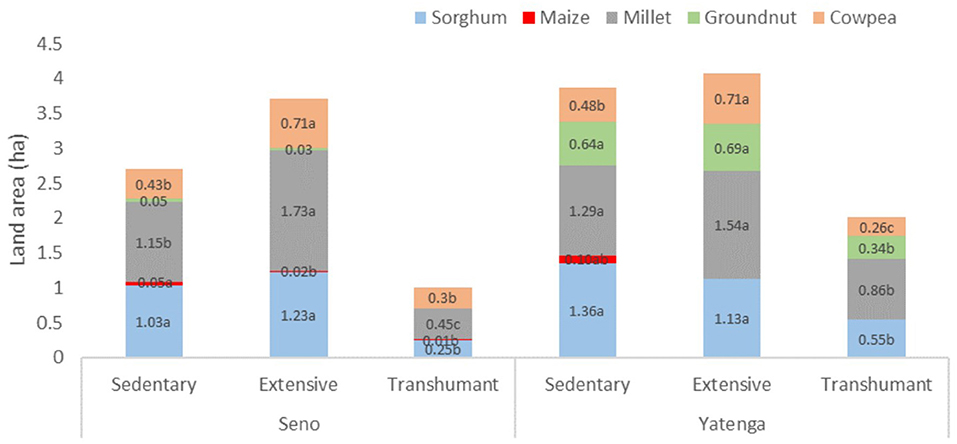
Figure 2. Land area cultivated for dominant crops utilize as feed resources by the respondents per Livestock Management System in the study sites.
According to the respondents in Yatenga province, livestock holding within the last 12 months ranged from 1.9 TLU in sedentary-extensive to 5.0 TLU in the sedentary-intensive system and 6.7 TLU in the transhumant system (Figure 3). In Seno, livestock holding in the sedentary-intensive system was 4.8 TLU, 5.3 TLU in the sedentary-extensive, and 11.6 TLU in the transhumant system. The number of goats was higher than the number of sheep within the total flock in Seno Province. In Yatenga, sheep flock was higher (P < 0.05) in sedentary-intensive and sedentary-extensive than in the transhumant system. As at the time of the study, livestock holdings (TLU) in all study sites were higher in the transhumant system than in the other management systems with higher (P < 0.05) cattle herd size.
Contribution of Different Feed Resources
Types and preferred livestock feed resources in the study areas varied across the provinces and among different livestock management systems in both wet and dry seasons (Figure 4). The contribution of different feed resources to livestock diet within different management systems in both study sites across seasons showed that natural pastures were the main source of feed for ruminants in the wet season, while crop residues (cereal straw, legume residues) largely become the major feed sources as the season progressed from wet to dry. Also, household by-products become increasingly important particularly in Seno province across the season, especially in the transhumant system.
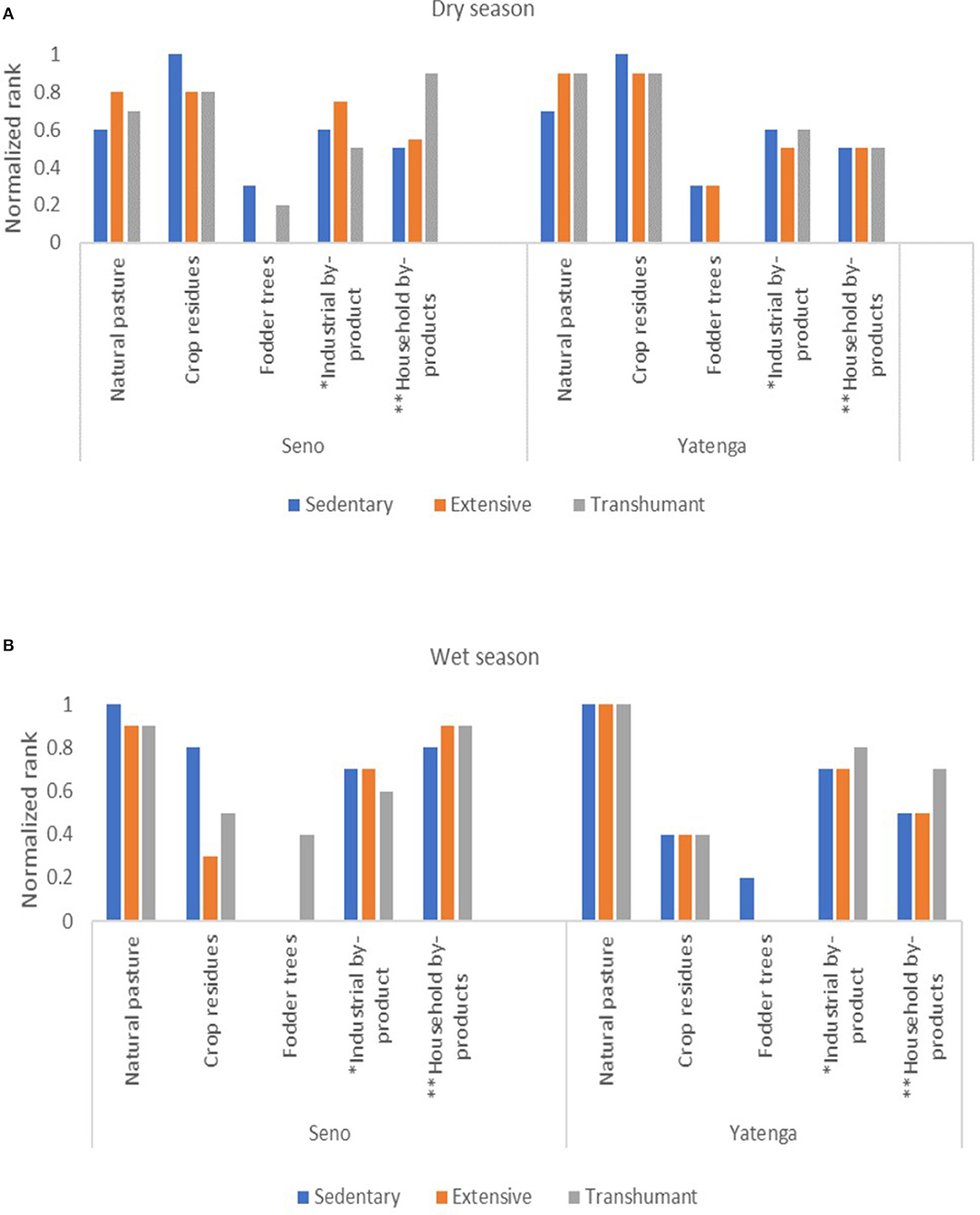
Figure 4. Contribution of different livestock feed resources in both Seno and Yatenga province at (A) dry and (B) wet seasons. *Cotton seed cake; **Cereals bran.
Livestock Beneficial Outputs
We measured livestock beneficial outputs in all the livestock management systems in terms of milk sold, livestock offtake, manure sold, and livestock services (traction) offered (Table 2). The result revealed higher milk production (liter/TLU) and sold and flock offtake (TLU) in the transhumant system. The quantity of manure gathered (kg/TLU) and sold were consistently higher (P < 0.05) in both intensive and extensive sedentary systems. The monetary values for manure production were similar (P > 0.05) in both the sedentary-intensive and sedentary-extensive systems in the Seno province and higher (P < 0.05) than 0.27 US$ per household recorded in the transhumant. Values for milk (40 US$) and offtake (313 US$) derived from the transhumant system were higher (P < 0.05) than those from other systems in Seno province. A similar trend was recorded in Yatenga province (Table 3). Values for livestock services differed only (P < 0.05) among the management systems in Yatenga province. Sedentary-intensive and sedentary-extensive systems derived similar values (24 and 26 US$, respectively) and higher than the values derived in the transhumant system.
Water Depletion and Livestock Water Productivity
The amount of feed estimated comprised crop residues derived from major food-feed crops (maize, millet, sorghum, groundnut, and cowpea) and nature pasture grass from grazing lands.
The amount of water depleted from the different feed types within the management systems varied significantly. Water depleted from crop residue was higher (P < 0.05) in the sedentary-intensive system (Table 4). However, total water depleted per household for feed production used in the study areas was similar (P > 0.05) among the management systems (Table 5). Water depleted ranged from 2,500 to 3,200 m−3 ha−1 yr−1, though values were higher numerically in the transhumant system than the others. With higher returns from the beneficial output in the transhumant households in Yatenga, LWP was highest (0.11 US$ m−3) in the transhumant system and lowest in the sedentary-extensive system (0.06 US$ m−3). In Seno, livestock beneficial output was similar in sedentary-intensive and transhumant systems but higher (P < 0.05) than in the sedentary-extensive system. The LWP followed a similar trend in Yatenga (Table 5). In both provinces, the sedentary-extensive system recorded the least LWP.
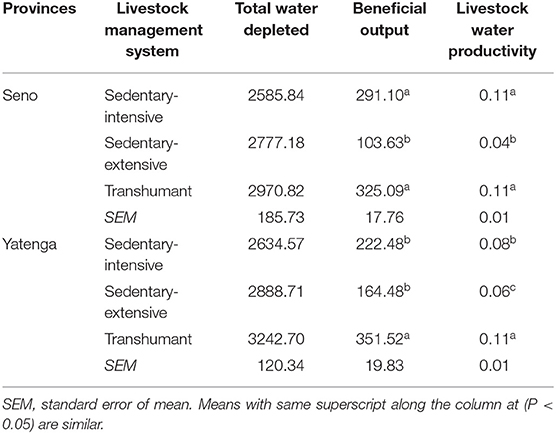
Table 5. Water depleted for livestock feed per household (m3 ha−1 yr−1), beneficial outputs per household (US$ household /year) and livestock water productivity (US$ m−3) in study sites.
Regression Analysis
We performed multiple regression analysis in a stepwise procedure to determine the relationship between livestock water productivity (LWP) and traction, manure, milk, and flock offtake. The model summary showed that among variables at Yatenga province only offtake showed a significant positive relationship with LWP while in Seno, flock offtake and milk were significant variables predicting LWP (Table 6). In Yatenga province, about 81.5% (F = 430.95) of the variation in the LWP is explained by net offtake while in Seno about 82.3 (F = 271.84) and 81.5 % (F = 518.74) of livestock water productivity (LWP) is explained by net milk and offtake. Furthermore, the regression analysis indicated that an increased number of cattle in the herd will result in more beneficial output especially in Seno where milk and offtake linearly improve LWP.
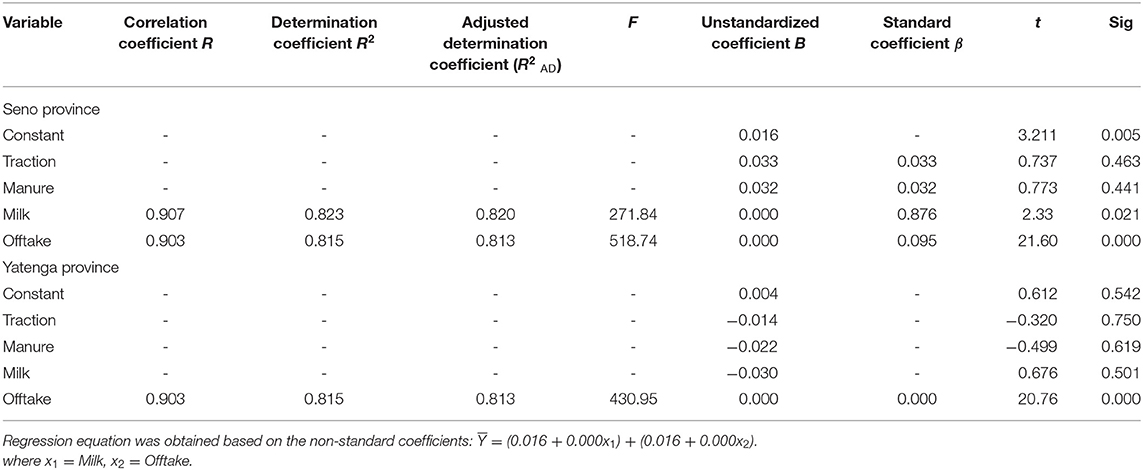
Table 6. Stepwise regression of beneficial output variables of livestock water productivity in the Seno and Yatenga provinces.
Discussion
The household size and composition are highly related to the available labor force which are the productive members of the family. Potential labor available for agricultural activities such as sowing and harvesting of crops, collection of crop residue and management of household herds, may ultimately contribute to agricultural productivity and LWP (Ayele, 2012).
Based on the livelihood options, a higher cultivated land area in Yatenga than Seno province is expected (Fraval et al., 2020). This may also explain greater crop diversity in Yatenga province when compared to Seno (Fraval et al., 2020). More crop diversity could lead to crop residues diversity (Gaudin et al., 2015) thereby, increasing the feed resource base within the province. Crop diversity leading to more crop residues with better nutritional values (Haileslassie et al., 2009) may improve the feeding value of crop residues and thereby, improve LWP (Gebreselassie et al., 2008). Among different livestock management systems, greater cropland in the sedentary-intensive and sedentary-extensive systems than the transhumant reflects the dominant primary occupation and ethnic variation.
Crop residues remain the main feed resources at the end of the wet season, which also coincided with the harvest period (Amole and Ayantunde, 2015) and the natural pastures during the wet season as shown in the study. From the study, there appears to be a similarity in the type of feed resources within each system in the study sites, though the proportion and water depleted from each feed type in the feed basket and seasonal preferences varied among the systems. Consequently, the contribution to total water depleted of different feed types was statistically the same. Contrary to results from other authors, variation in LWP among systems in both provinces is not influenced by the amount of water used in producing feed particularly when feed resources are similar even though differed in proportion. One key strategy for increasing LWP lies in selecting feed sources that use relatively little water (crop residues, natural pasture and agro-byproducts) or that use water that has little value for other human needs for support of ecosystem services. Livestock across the systems in this study sites depend on extensive grazing, crop residues and byproducts (Peden et al., 2007, Descheemaeker et al., 2013) and may influence the LWP when compared with systems where livestock depend on feeds that use more amount of water. In interpreting the result of the water used for feed, which was similar in all system at both provinces, it is important to note that the study used an estimated biomass yield for the Sahel (as mentioned on the materials and method) considering the grazing area as homogenous species in estimating the water depletion of grazing areas. This does not reflect the real scenario as there is spatial variability in yield across different locations in the Sahel (Bayala et al., 2014). Premised on similarity in the water depletion through feed in all the systems in both provinces, the results showed that variation in LWP reflects varying beneficial outputs among systems. Such variation in the different components of benefits derived from livestock specific to each system is expected based on the difference in socioeconomic profiles of the study communities.
Higher dependence on communal grazing land especially within the sedentary-extensive may lead to over-exploitation of more feed and water and less water productivity. in the study sites (Bekele et al., 2017). This an entry point for natural resource management strategies to improve productivity and condition of the communal land. Although the sedentary-extensive household cultivated more land, the dependence on crop residue is lower as most residues are left on the farm to be grazed. The opportunity to further improve LWP in the study sites is feasible through improving the collection, storage and feeding techniques of crop residues (Blümmel et al., 2003).
Preference for feed type differed across the system, province, and season, based on herd size, production target and probably feed available. There is a higher preference for crop residue in the sedentary-intensive system in both seasons to meet the feed demand arising from higher herd size especially in Yatenga. With higher herd size in transhumant, feed demand is usually met by the cyclical movement of their large herd size into areas where natural resource availability is highly variable in time and space (Niamir-Fuller, 1999). It follows that transhumant takes advantage of pastures and water, which a naturally not in direct use but contribute to the ecosystem to meet the feed gap. The large herd size has been reported as important in the pastoral societies as a symbol of wealth and to strengthen social ties within the transhumant system in the Sahel (De Haan et al., 2016; Thebaud, 2017). Transhumant households specifically and culturally keep cattle for status, milk production and rarely for draft and manure production. The monetary value for milk and flock-offtake in the region is higher than other livestock outputs. This is likely to affect the LWP.
Generally, LWP results for each livestock management system in this study are comparable with results (US$ 0.07 m−3 and US$ 0.09 m−3 for rich farmers and poor farmers, respectively) in areas with water stress in Ethiopia (Mekonnen et al., 2011). Our results suggest that livestock water productivity within the same agro-ecology varies among livestock management systems depending on farmers' livelihood options and services derived from livestock. Values obtained in this study were lower than reported by Gebreselassie et al. (2009) where water depleted for feed and the beneficial outputs were also higher than values in this study. It, therefore, follows that where the beneficial output could be improved without increasing the water depleted for feed, livestock production can be water productive (Peden et al., 2007). This fact is strengthened within the result observed among the transhumant system in both provinces where livestock production is more water productive than the other systems in with regards to higher beneficial outputs. Similarly, in Seno, where the sedentary-intensive system recorded higher beneficial outputs, LWP was similarly higher than the sedentary-extensive system. Transhumance livestock system has been recognized as efficient and adaptive use of dryland vegetation and water resources as explained by the mobility paradigm underpinning transhumance in West Africa (Moritz 2008; Ayantunde et al., 2014). However, some authors have raised concern about its perceived effect on the natural resource management and socio-economic well-being of the host communities in the Sudano-Guinean zone especially through competition for grazing resources (Ayantunde et al., 2014).
Variability in the contribution of each beneficial output that influenced the values of LWP tends to be related to the variation in each livestock management system. The outcome of this study revealed that among those variables examined, milk and offtake improve LWP within the transhumant and the sedentary-intensive systems in Seno whereas only offtake seems to improve LWP in Yatenga. This implies that inputs that can increase offtake in Yatenga, and offtake and milk in Seno will most likely increase LWP. Because livestock is raised as means of risk diversification mostly by the households practicing sedentary-extensive management system, beneficial output in terms of flock offtake was lower. More flock offtake in the transhumant system is made possible by a high number of livestock holding and probably, better market access. The mobility of transhumant stock allows herders to access markets to sell livestock, which is often far from the best production zones (IIED and SOS Sahel, 2009). Furthermore, meat and milk are the major outputs, and milk is produced for home consumption first before sale within the transhumant system. On the other hand, in the mixed crop-livestock systems, farmers majors on crop production and then animals are raised for meat, manure and draft power (Kamuanga et al., 1999). In an unpublished report, fresh milk from a cow was rarely consumed in Yatenga province with predominantly Mossi crop farmers, unlike in Seno province, predominantly FulBe, where milk was sourced through the own-farm channel and regularly consumed. This result confirmed that livestock water productivity is positively related to animal productivity (Mekonnen et al., 2011) and livestock multiple-use leads to increased LWP (Panin and Brokken, 1993; Peden et al., 2007).
The monetary values for benefits derived from livestock are important and consequently influence the LWP as shown in the study. Households within the sedentary-extensive system derived more benefit in terms of services (traction) and manure which also reflect the sizes of cultivated land. However, the monetary values derived from milk and flock offtake are higher and as such, their contribution to total beneficial outputs. Furthermore, the higher number of cattle in the transhumant herd did not reflect in the value for services in terms of draft as most of the transhumant household cultivate a smaller area of land compared to others (Erenstein et al., 2007), and do not also engage in rent/lease of animal for traction according to the respondents. Lower beneficial outputs derived from manure in the transhumant system could be explained as what the respondent described as cultural. Most transhumance Peulh interviewed considered the sale of manure collected from cattle as a taboo. However, monetary values from milk and offtake contribute to increased LWP in the transhumant system.
Estimating the components of livestock water productivity was based on several assumptions due to a lack of data as described above. Beneficial outputs are based on actual sales, excluding the indirect benefits to the farmer and households. Based on these, it is recognized that the methods of estimation employed in the study may overestimate or underestimate livestock productivity. This factor has to be considered when interpreting the results for further study.
Conclusion
The results of the present study had its value revealed in that livestock water productivity varies among livestock management systems in the Sahel was most strongly related to beneficial outputs derived from livestock especially, milk and flock offtake. Both sedentary-intensive and transhumant systems with more market-oriented beneficial outputs had higher LWP. Furthermore, the similarity in the type of feed resources across all systems, though different proportions, influence the similar values of water depleted in all the systems. Consequently, the water cost for feed is similar in all systems. Change in feed resource base into more-water-demand feed type, as livestock production evolves in the Sahelian region, may influence LWP. Therefore, livestock water productivity of the livestock management systems in the study area and similar systems in West Africa can be improved through interventions that enhance the total beneficial outputs (flock and milk offtake) from the systems. Also, the link between culture and livestock management system was evident in this study. Therefore, interventions to improve livestock water productivity through beneficial outputs must recognize the unique socio-cultural context of the livestock farmers.
Data Availability Statement
The original contributions presented in the study are included in the article/supplementary material, further inquiries can be directed to the corresponding author.
Ethics Statement
Written informed consent was obtained from the individual(s) for the publication of any potentially identifiable images or data included in this article.
Author Contributions
AAy: conceptualization and supervision. TA: investigation and writing. AAd and TA: formal analysis. All authors review and editing.
Conflict of Interest
The authors declare that the research was conducted in the absence of any commercial or financial relationships that could be construed as a potential conflict of interest.
Acknowledgments
We thank all donors and organization who globally supported ILRI and in its work through their contribution to the CGIAR system. We acknowledge the logistics and technical support ILRI staffs in Ouagadougou and Ibadan. Special Alan Duncan for the review.
References
Abdoulaye, T., and Lowenberg-de Boer, J. (2000). Intensification of Sahelian farming systems: evidence from Niger. Agric. Syst. 64, 67–81. doi: 10.1016/S0308-521X(00)00014-7
Adugna, T., and Said, A. N. (1994). Assessment of feed resources in Welayta Sodo. Eth. Agric. Sci. 14, 69–87.
Amole, T. A., and Ayantunde, A. A. (2015). Assessment of existing and potential feed resources for improving livestock water productivity in communities around small reservoirs in Yatenga province. Burkina Faso Technical Report for IWMI EC-IFAD Water for Food Project, International Livestock Research Institute, Nairobi, Kenya.
Amole, T. A., and Ayantunde, A. A. (2016). Improving livestock productivity: assessment of feed resources and livestock management practices in Sudan-Savanna zones of West Africa. Afr. J. Agric. Res. 11, 422–440. doi: 10.5897/AJAR2015.10460
Ayantunde, A. A., Asse, R., Said, M. Y., and Fall, A. (2014). Transhumant pastoralism, sustainable management of natural resources and endemic ruminant livestock in the sub-humid zone of West Africa. Environ. Dev. Sustain. 16, 1097–1117. doi: 10.1007/s10668-014-9515-z
Ayantunde, A. A., Cofie, O., and Barron, J. (2018). Multiple uses of small reservoirs in crop-livestock agro-ecosystems of Volta basin: implications for livestock management. Agric. Water Mgt. 204, 81–90. doi: 10.1016/j.agwat.2018.04.010
Ayantunde, A. A., Hiernaux, P., Fernandez-Rivera, S., van Keulen, H., and Udo, H. M. J. (1999). Selective grazing by cattle on spatially and seasonally heterogeneous rangeland in Sahel. J. Arid Env. 42, 261–279. doi: 10.1006/jare.1999.0518
Ayantunde, A. A., Leeuw, J. D., Turner, M. D., and Said, M. (2011). Challenges of assessing the sustainability of (agro)-pastoral systems. Livestock Sci. 139, 30–43. doi: 10.1016/j.livsci.2011.03.019
Ayantunde, A. A., Oluwatosin, B. O., Yameogo, V., and van Wijk, M. (2020). Perceived benefits, constraints and determinants of sustainable intensification of mixed crop and livestock systems in the Sahelian zone of Burkina Faso. Int. J. Agric. Sustain. 18, 84–98. doi: 10.1080/14735903.2019.1698494
Ayele, A. (2012). Study of small-holder farms livestock management practices and their implications on livestock water productivity in mixed crop-livestock systems in the highlands of Blue Nile basin: a case study from Fogera, Diga and Jeldu districts (Ethiopia). MSc. Thesis. Hawassa University Ethiopia, Hawassa, Ethiopia.
Bacye, B., and Bor, A. (2011). Study of organic matter flows on farms in the Western Cotton Zone of Burkina Faso. Tropicultura 29, 148–152. Available online at: https://doaj.org/article/c172d7cc1c9e41e8abc053c56070f132
Bayala, J., Ky-Dembele, C., Kalinganire, A., Olivier, A., and Nantoume, H. (2014). A Review of Pasture and Fodder Production and Productivity for Small Ruminants in the Sahel, ICRAF Occasional Paper No. 21. Nairobi: World Agroforestry Centre.
Bekele, M., Mengistu, A., and Tamir, B. (2017). Livestock and feed water productivity in the mixed crop-livestock system. Animal 11, 1852–1860. doi: 10.1017/S1751731117000416
Bidjokazo, F., Zacharie, Z., and Guillaume, E. (2012). “Promoting sustainable crop-livestock integration through farmer's participation and integrated soil fertility management in the Sahel of West Africa,” in Soil Fertility Improvement and Integrated Nutrient Management - A Global Perspective, ed J. Whalen (InTech). Available online at: http://www.intechopen.com/books/soilfertility-improvement-and-integrated-nutrient-management-a-global-perspective/promoting-sustainable-croplivestock-integration-through-farmer-s-participation-and-integrated-soil (accessed October 12, 2020).
Blümmel, M., Zerbini, E., Reddy, B. V. S., Hash, C. T., Bidinger, F., and Khan, A. A. (2003). Improving the production and utilization of sorghum and pearl millet as livestock feed: progress towards dual-purpose genotypes. Field Crops Res. 84, 143–158.
Breman, H., and de Ridder, N. (1991). Manuel sur les paöturages des pays saheliens. Paris/Wageningen: Karthala/ACCT/CTA, 485.
Catholic Relief Services (CRS) (2014). Adapting to the Sahel's changing climate: local approaches. An economic and technical feasibility analysis of adaptation techniques in Niger, Burkina Faso and Mali. CRS, Baltimore, MD, United Staes.
De Haan, C., Dubern, P.E., Garancher, B., and Quintero, C. (2016). Pastoralism Development in the Sahel: a Road to Stability? Washington, DC: World Bank Group. Available online at: http://documents.worldbank.org/curated/en/586291468193771160/Pastoralism-development-in-the-Sahel-a-road-to-stability
De Leeuw, P. N., and Tothill, J. C. (1990). The concept of rangeland carrying capacity in sub-Saharan Africa - myth or reality. Paper No. 29b. Pastoral Development Network, London, United Kingdom, 20.
Delgado, C., Rosegrant, M., Steinfeld, H., Ehui, S., and Courbois, C. (1999). Livestock to 2020: The Next Food Revolution. Food, Agriculture and the Environment Discussion Paper 28. Washington, DC: IFPRI/FAO/ILRI.
Descheemaeker, K., Amede, T., and Haileslassie, A. (2009). Livestock and water interactions in mixed crop-livestock farming systems of sub-Saharan Africa: interventions for improved productivity. IWMI Working Paper 133, International Water Management Institute, Colombo, Sri Lanka, 44.
Descheemaeker, K., Amede, T., and Haileslassie, A. (2010). Improving water productivity in mixed crop–livestock farming systems of sub-Saharan Africa. Agric. Water Manage. 97, 579–586. doi: 10.1016/j.agwat.2009.11.012
Descheemaeker, K., Bunting, S. W., Bindraban, P., Muthuri, C., Molden, D., Beveridge, M., et al. (2013). “Increasing water productivity in agriculture,” in Managing Water and Agroecosystems for Food Security, ed E Boelee (Wallingford: CAB International), 104–123. doi: 10.1079/9781780640884.0104
Diallo, L., and Boundaogo, M. (2011). Les principales filières agro-sylvo-pastorales de la province du Sanmatenga. Ouagadougou: SNV.
Dicko, M. S., Djitèye, M. A., and Sangaré, M. (2006). Les systèmes de production animale au Sahel. Sécheresse 17, 83–97. Available online at: https://www.jle.com/fr/revues/sec/e-docs/les_systemes_de_production_animale_au_sahel_270090/article.phtml
Diop, A. T., Touré, O., Ickowicz, A., and Diouf, A. (2005). “Les ressources sylvopastorales,” in Bilan de la recherche agricole et agroalimentaire au Sénégal (Dakar: Institut Sénégalais de Recherches Agricoles/Institut de Technologie Alimentaire/Centre de Coopération Internationale en Recherche Agronomique pour le Développement), 91–105.
Douxchamps, S., Ayantunde, A., Panyan, E. K., Ouattara, K., Kaboré, A., Karbo, N., et al. (2014). Agricultural water management and livelihoods in the crop– livestock systems of the Volta Basin. Water Res. Rural Dev. 6, 92–104. doi: 10.1016/j.wrr.2014.10.001
Erenstein, O., Thorpe, W., Singh, J., and Varma, A. (2007). “Crop-livestock interactions scoping study- Synthesis,” in Crop-Livestock Interactions and Livelihoods in the Indo-Gangetic Plains, India: A Regional Synthesis (New Delhi: CIMMYT-ILRI-RWC).
FAO (1992). CROPWAT: A computer program for irrigation planning and management. Developed by: Martin Smith. FAO Irrigation and Drainage Paper 46, Rome, Italy.
FAO (2003). Water Resources Development and Management Service. Available online at: http://www.fao.org/ag/agl/aglw/cropwat.stm (accessed January 7, 2021).
FAO (2014). Socio-economic context and role of agriculture. FAPDA country fact sheet on food and agriculture policy trends, Burkina Faso. FAPDA, Rome, Italy.
Fernandez-Rivera, S., Hiernaux, P., Williams, T. O., Turner, M. D., Schlecht, E., Salla, A., et al. (2005). “Nutritional constraints to grazing ruminants in the millet-cowpea-livestock farming system of the sahel,” in Coping with Feed Scarcity in Smallholder Livestock Systems in Developing Countries, eds A. A. Ayantunde, S. Fernandez-Rivera, and G. McCrabb (Nairobi: SFIT and ILRI), 306.
Fontes, J., and Guinko, S. (1995). Carte de végétation et de l'occupation du sol du Burkina Faso. Laboratoire d'Ecologie Terrestre, Institut de la Carte Internationale de la Végétation. CNRS, Université de Toulouse III (France)/Institut du Développement Rural, Faculté des Sciences et Techniques, Université de Ouagadougou, Burkina Faso, 69.
Fraval, S., Yameogo, V., Ayantunde, A., Hammond, J., de Boe, I. J. M., Oosting, S. L., et al. (2020). Food security in rural Burkina Faso: the importance of consumption of own-farm sourced food versus purchased food. Agric. Food Security 9:2. doi: 10.1186/s40066-020-0255-z
Gaudin, A. C. M., Tolhurst, T. N., Ker, A. P., Janovicek, K., Tortora, C., Martin, R. C., et al. (2015). Increasing crop diversity mitigates weather variations and improves yield stability. PLoS ONE 10:e0113261. doi: 10.1371/journal.pone.0113261
Gebreselassie, S., Peden, D., Haileslassie, A., and Mpairwe, D. (2008). “Cost-effective assessments of livestock-water productivity using previous feeding trials,” in Proceeding of CPWF Second International Workshop (Addis ababa Ethiopia).
Gebreselassie, S., Peden, D., Haileslassie, A., and Mpairwe, D. (2009). Factors affecting livestock water productivity: animal scale analysis using previous cattle feeding trials in Ethiopia. Rangel. J. 31, 251–258. doi: 10.1071/RJ09011
Gomgnimbou, A. P. K., Nacro, H. B., Sanon, A. P., Sedogo, M., and Martinez, J. (2014). Observed effects of the animal manure application practices on the chemical parameters and status of Lixisols in the south Sudanian zone (Bobo-Dioulasso, Burkina Faso). J. Biodiv. Environ. Sci. 5, 214–227. Available online at: https://hal.archives-ouvertes.fr/hal-01068496/document
Grouzis, M., and Sicot, M. (1980). “A method for phonological study of browse populations in the Sahel: the influence of some ecological factors,” in Browse in Africa. The Current State of Knowledge, ed H. N. Le Houérou (Addis Ababa: ILCA), 233–240.
Haileslassie, A., Peden, D., Gebreselassie, S., Amede, T., and Descheemaeker, D. (2009). Livestock water productivity in mixed crop–livestock farming systems of the Blue Nile Basin: assessing variability and prospects for improvement. Agric. Syst. 102, 33–40. doi: 10.1016/j.agsy.2009.06.006
Hiernaux, P., Mougin, E., Diarra, L., Soumaguel, N., Lavenu, F., Tracol, Y., et al. (2009). Sahelian rangeland response to changes in rainfall over two decades in the Gourma region, Mali. J. Hydrol. 375, 114–127. doi: 10.1016/j.jhydrol.2008.11.005
IIED SOS Sahel (2009). Modern and Mobile. The Future of Livestock Production in Africa's Drylands. London: International Institute for Environment and Development and SOS Sahel International. Available online at: http://pubs.iied.org/pdfs/12565IIED.pdf (accessed July 16, 2020).
INERA (Institut de l'Environnement et de Recherches Agricoles) (1995). Etat des lieux sur les pratiques d'utilisation des ressources naturelles renouvelables au Burkina Faso. Ouagadougou: INERA.
Kamuanga, M., d'Ieteren, G. D. M., Tano, K., Jabbar, M. A., Swallow, B. M., and Pokou, K. (1999). “Farmer preferences of cattle breeds, their market values and prospects for improvement in West Africa: a summary review,” in Proceedings of the 25th Meeting of the International Scientific Council for Trypanosomiasis Research and Control, Mombasa, Kenya, 27 September to 2 October 1999, ed K. R. Sones (Nairobi: Organization of African Unity/International Scientific Council for Trypanosomiasis Research and Control), 271–298.
Kurz, I., O'Reilly, C. D., and Tunney, H. (2006). Impact of cattle on soil physical properties and nutrient concentrations in overland flow from pasture in Ireland. Agric. Ecosyst. Environ. 113, 378–390. doi: 10.1016/j.agee.2005.10.004
Le Houérou, H. N., and Hoste, C. (1977). Rangeland production and annual rainfall relations in the Mediterranean Basin and in the African Sahelosudanian zone. J. Range Manage. 30, 181–189. doi: 10.2307/3897463
Mekonnen, S., Descheemaeker, K., Tolera, A., and Amede, T. (2011). Livestock water productivity in a water stressed environment in Northern Ethiopia. Exp. Agric. 47, 85–98. doi: 10.1017/S0014479710000852
Ministry of Livestock Resources MRA (2007). Plans d'actions pour le développement des filières bétailviande et petits ruminants. Premiére. partie: Diagnostic des filières - Rapport final. Ouagadougou: Ministry of Livestock Resources MRA.
Ministry of Livestock Resources M. R. A. (2011). Document de plaidoyer du sous-secteur de l'élevage. Ouagadougou: Burkina Faso.
Niamir-Fuller, M. (1999). Managing mobility in African rangeland. London: Intermediate Technology Publications. Available online at: http://citeseerx.ist.psu.edu/viewdoc/download?doi=10.1.1.446.8608andrep=rep1andtype=pdf (accessed January 7, 2021).
Panin, A., and Brokken, R. F. (1993). “Economic analysis of cow traction farm technology in the Ethiopian Highlands,” in Research for Development of Animal Traction in West Africa, eds P. R. Lawrence, K. Lawrence, J. T. Dijkman, and P. H. Starkey (Addis Ababa: ILCA), 306.
Peden, D., Taddesse, G., and Haileslassie, A. (2009). Livestock water productivity: implications for sub-Saharan Africa. Rangel J. 31, 187–193. doi: 10.1071/RJ09002
Peden, D., Taddesse, G., and Mammo, M. (2003). “Improving the water productivity of Livestock: an opportunity for poverty reduction,” in Integrated Water and Land Management Research and Capacity Building Priorities of Ethiopia, eds P. G. McCornick, P. G. Kamara, A. B. Tadesse Girma (Addis Ababa: ILRI). p. 57.
Peden, D., Tadesse, G., and Misra, A. (2007). “Water and livestock for human development,” in Water for Food, Water for Life: A Comprehensive Assessment of Water Management in Agriculture, ed D. Molden (Colombo: International Water Management Institute and London: Earthscan. p. 354).
Sanon, H. O., Kaboré-Zoungrana, C., and Ledin, I. (2007). Edible biomass production from some important browse species in the Sahelian zone of West Africa. J. Arid Environ. 71, 376–392. doi: 10.1016/j.jaridenv.2007.03.019
Sanou, J., Bationo, B. A., Barry, S., Nabie, L. D., Bayala, J., and Zougmore, R. (2016). Combining soil fertilization, cropping systems and improved varieties to minimize climate risks on farming productivity in northern region of Burkina Faso. Agric Food Secur. 5:20. doi: 10.1186/s40066-016-0067-3
Some, L., Dembele, Y., Ouedraogo, M., Some, B. M., Kambire, F. L., and Sangare, S. (2006). Analysis of Crop Water Use and Soil Water Balance in Burkina Faso Using Cropwat, CEEPA DP36. Pretoria: University of Pretoria.
Steinfeld, H., Gerber, P., Wassenaar, T., Castel, V., Rosales, M., and de Haan, C. (2006). Livestock's Long Shadow: Environmental Issues and Options. Rome: Food and Agriculture Organization (FAO)
SWAC/OECD (2007). Promoting and supporting change in transhumant pastoralism in the Sahel and West Africa. Policy note number 3. SWAC/OECD, Paris, France, 4.
Thebaud, B. (2017). Pastoral and Agropastoral Resilience in the Sahel: Portrait of the 2014-2015 and 2015-2016 Transhumance (Senegal, Mauritania, Mali, Burkina Faso, Niger). Available online at: http://www.inter-reseaux.org/IMG/pdf/afl_resilience_study_june2017_abridged_version.pdf (accessed January 7, 2021).
Thiombiano, A., Schmidt, M., Dressler, S., Ouedraogo, A., Hahn, K., and Zizka, G. (2012). Catalogue des plantes vasculaires du Burkina Faso [Catalogue of the vascular plants of Burkina Faso]. Boissiera 65, Conservatoire et Jardin Botaniques, Genève, 391.
Thornton, P., and Herrero, M. (2001). Integrated crop–livestock simulation models for scenario analysis and impact assessment. Agric. Syst. 70, 581–602. doi: 10.1016/S0308-521X(01)00060-9
Wright, I. A. (2013). “Improving livestock water productivity,” in Paper Presented at the Conference on Food Safety, Security, and Defense (FSSD), Nebraska, United States, 20 -23 October 2013.
Wylie, B. K., Denda, I., Pieper, R. D., Harrington, J. A., Reed, B. C., and Southward, G. M. (1995). Satellite-based herbaceous biomass estimates in the pastoral zone of Niger. J. Range Manage. 48, 159–164. doi: 10.2307/4002804
Keywords: management systems, water productivity, livestock, Sahel, feed resources
Citation: Amole TA, Adekeye A and Ayantunde AA (2021) Assessment of Livestock Water Productivity in Seno and Yatenga Provinces of Burkina Faso. Front. Sustain. Food Syst. 5:632624. doi: 10.3389/fsufs.2021.632624
Received: 23 November 2020; Accepted: 22 March 2021;
Published: 22 April 2021.
Edited by:
Yaosheng Wang, Chinese Academy of Agricultural Sciences, ChinaReviewed by:
Katrien Descheemaeker, Wageningen University and Research, NetherlandsGuobao Song, Dalian University of Technology, China
Copyright © 2021 Amole, Adekeye and Ayantunde. This is an open-access article distributed under the terms of the Creative Commons Attribution License (CC BY). The use, distribution or reproduction in other forums is permitted, provided the original author(s) and the copyright owner(s) are credited and that the original publication in this journal is cited, in accordance with accepted academic practice. No use, distribution or reproduction is permitted which does not comply with these terms.
*Correspondence: Tunde Adegoke Amole, dC5hbW9sZUBjZ2lhci5vcmc=
 Tunde Adegoke Amole
Tunde Adegoke Amole Adetayo Adekeye1
Adetayo Adekeye1